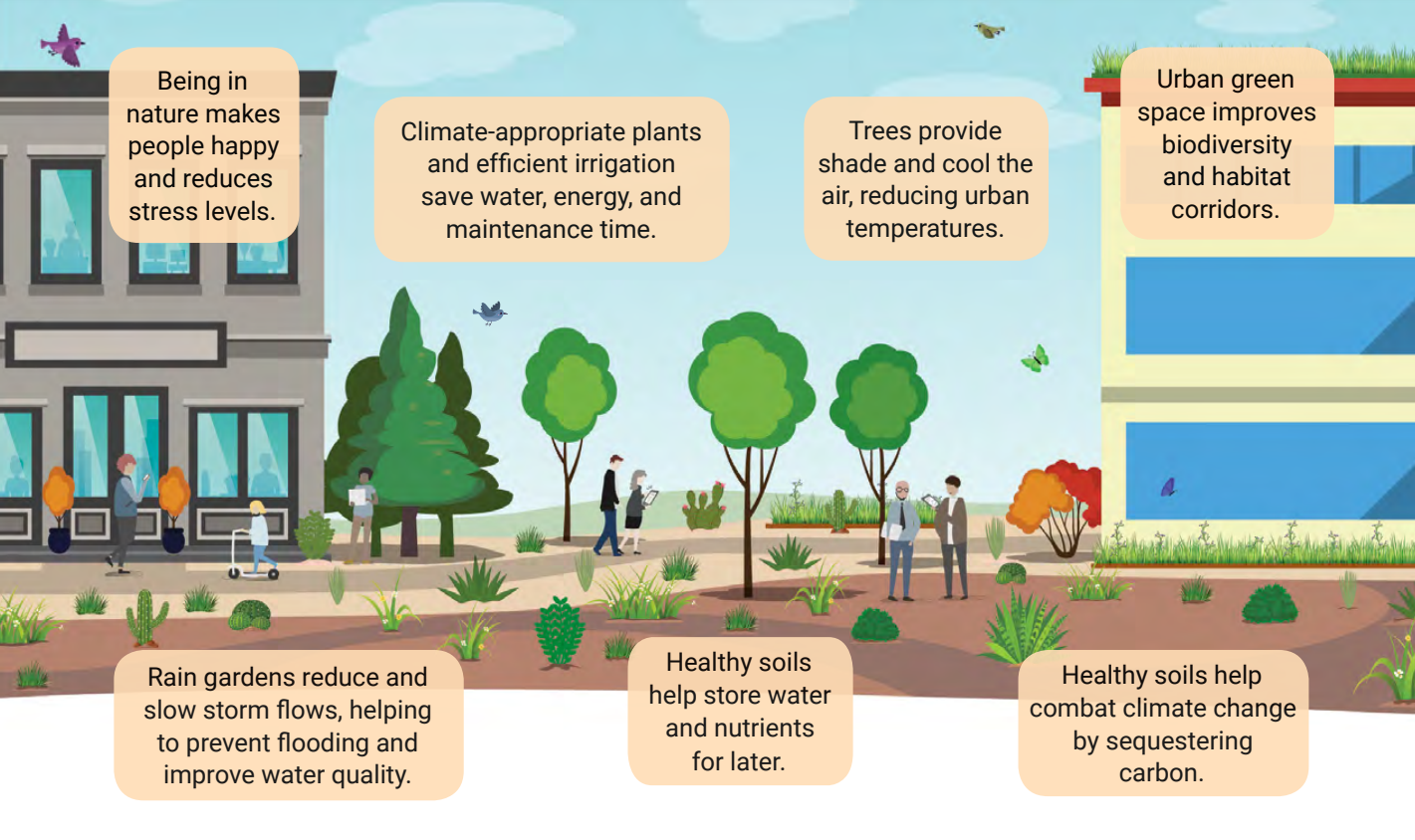California non-functional turf irrigation ban provides businesses an opportunity to step up on sustainability
By Cora Kammeyer and Dr. Sonali Abraham
Pacific Institute research finds conversion of CII landscapes to more sustainable landscapes in California could save between 340,000 and 400,000 acre-feet of water per year.
Key takeaways
- New emergency drought regulations ban irrigation of non-functional turf on commercial, industrial, and institutional (CII) sites across urban California.
- The ban presents a unique opportunity for California’s business community to demonstrate sustainability leadership through proactive drought response.
- By transforming to more sustainable landscaping, businesses can contribute to immediate drought relief and long-term water resilience, while achieving corporate sustainability goals, cutting costs, and providing additional community co-benefits.
- Pacific Institute tools and resources can help businesses explore options and get started on a landscape transformation.
A new ban on non-functional turf irrigation in California—part of recently announced emergency drought regulations—provides a unique opportunity for California’s business community to demonstrate sustainability leadership through proactive drought response. On May 24, 2022, the California State Water Resources Control Board (State Water Board) adopted an emergency regulation in response to ongoing and intensifying drought conditions across the state. This regulation comes in response to Executive Order N-7-22 signed by Governor Newsom asking for increased water conservation that includes specific mandates for urban water suppliers and select water users. The Executive Order and ensuing regulation include specific actions targeted at the commercial, industrial, and institutional (CII) sector, which includes commercial businesses, manufacturing and distribution, hospitals, government buildings, and other institutions.
Banning irrigation of non-functional turf
The State Water Board’s emergency drought regulation imposes a temporary ban on irrigation of non-functional turf with drinking water on commercial, industrial, and institutional (CII) properties. It does not include turf irrigated with recycled water and specifies that the irrigation ban should not harm the health of trees or other non-turf plantings. California is not the first location to take such actions. This short-term drought regulation is coming shortly after Las Vegas moved to permanently ban irrigation of non-functional turf.
What is “non-functional turf”?
As defined by the state, “non-functional turf” is solely ornamental and not regularly used for recreation. It includes areas not in active use but still requiring maintenance, such as street medians and office parking lots. Non-functional turf does not include sports fields or turf regularly used for human recreational purposes or for civic or community events.
What properties does the non-functional turf ban apply to?
This ban applies to, for example, offices, stores, malls, manufacturing facilities, and warehouses, as well as schools, hospitals, government buildings, and other institutions. It also includes large apartment buildings and common areas owned by homeowners’ associations but not individual residences.
Opportunity for businesses to demonstrate sustainability commitment
While banning irrigation of non-functional turf is an important short-term response to a severe drought, we also must address the long-term problem of vast expanses of water-intensive turf across California communities. Over half of urban water use in California goes to landscape irrigation, and that portion is much higher in the hot, dry parts of California.
During the last California drought, we saw some commercial and industrial sites across the state making this transition, which helped California’s urban communities meet then-Governor Brown’s emergency drought mandate of reducing water use by 25 percent. But we can and must do more.
Commercial and industrial sites are disproportionately landscaped with turf compared to residential sites, and replacing turf with efficiently irrigated, climate-appropriate plants can reduce landscape water needs by 70 to 80 percent.
Unlocking untapped water savings potential
According to Pacific Institute research, conversion of CII landscapes to more sustainable landscapes in California could save between 340,000 and 400,000 acre-feet of water per year – and a ban on non-functional turf could help to realize some of those savings. By drawing CII water users’ attention to landscape management, the new emergency drought regulation provides an opportunity for transformations from unsustainable, nonfunctional turf into more sustainable landscapes. By heeding this call and embracing landscapes better suited to California’s climate, businesses can publicly demonstrate their commitment to sustainability and help meet their water stewardship goals and other sustainability targets.
Achieving corporate sustainability goals, cutting costs, and providing community benefits
The numerous benefits of sustainable landscapes can improve the cost-effectiveness of a landscape transformation project and provide an opportunity to publicly demonstrate the company’s commitment to the triple bottom line: people, planet, and profit.
For example, Pacific Institute researchers are working with one California commercial site spending $300,000 per year to irrigate eight acres of non-functional turf. Transforming that turf to sustainable landscaping would cut the site’s water use by 70-80 percent, saving nearly $200,000 per year on water bills.
This turf transformation would also help the company achieve its sustainability goals, while providing a range of co-benefits, including stormwater retention, site beautification, urban heat reduction, carbon sequestration, pollinator habitat, employee education, and maintenance cost savings.

Pacific Institute tools help companies take action
With the right tools, guidance, and encouragement, California businesses are well-positioned to help lead the way on the transition to more sustainable, drought-resilient urban landscapes. The Pacific Institute’s sustainable landscapes guidebook provides simple, step-by-step guidance aimed specifically toward businesses in California. The guidebook includes information on turf replacement, installation of bioswales and rain gardens, permeable pavement, green roofs, and rain tanks and cisterns. Self-assessment worksheets on current landscape conditions, decision-making, and drivers for landscape transformation walk the user through the process; infographics like the one above illustrate the benefits of sustainable landscapes.
Adapting to a more arid future
Given that California is one of the largest economies in the world, California businesses have an especially important role to play in helping address the state’s water challenges. Businesses can start with simple, cost-effective actions like landscape transformations on their properties. California’s water crisis is not a unique story. Outside of the US, almost every continent is experiencing some level of drought. Actions taken and lessons learned in response to water scarcity in urban California can be shared and transferred to help other water-stressed cities around the world.


